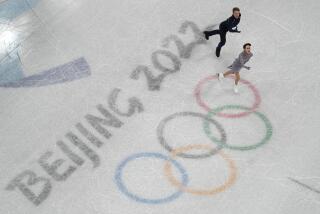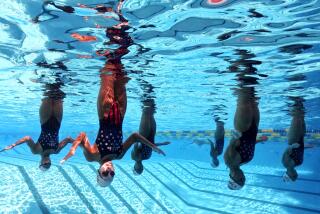Olympic To-Do List: Remember Gas Mask
- Share via
ATHENS — As part of their “welcome to Athens” processing by U.S. officials, American athletes are receiving their Team USA uniforms, official Olympic credentials and -- in a reflection of the unsettled security climate here -- a demonstration of how to use an emergency breathing device.
“When they pull out a mask, you’re like, ‘A mask?’ What do you need a mask for?” said Lisa Fernandez, the 33-year-old softball star from Long Beach, who checked in Friday as the Olympic village opened.
Team trainers will carry the masks, because U.S. officials reasoned that issuing them directly to the athletes would prove overly distracting. More than 1,000 of the devices are at hand, U.S. officials said -- more than enough for the entire U.S. delegation.
“It’s better to have all your bases covered than not,” added Lori Harrigan, 33, a security supervisor at the Bellagio hotel and casino in Las Vegas who, like Fernandez, is a softball pitcher and two-time gold-medalist.
The mask is not designed to provide protection in case of a chemical, biological or radiological attack.
Instead, it is a thin sheet aimed at dispelling the effects of irritants such as mace, pepper spray or tear gas. “It’s a thin piece of plastic with a little hole for ventilation, to breathe out of,” Fernandez said.
“We didn’t look at it like a gas mask,” Harrigan said. “It was just a little plastic bag.”
U.S. officials were motivated by an incident last Aug. 16 at the Pan American Games in Santo Domingo, the Dominican Republic, when police there sprayed a chemical substance to disperse thousands of fans outside an arena awaiting the gold-medal women’s volleyball match between Cuba and the host Dominican team.
“The only mask we think of is something hard that a catcher wears. Or something a firefighter or someone in the military would wear,” Fernandez said. “But when they showed it to us, and explained why they were doing it, it was not intimidating.”
She also said security planners as well as U.S. team officials deserve credit. Once the original shock of seeing the device wears off, she said, “You realize they’re trying to be proactive.”
Jim Scherr, chief executive of the U.S. Olympic Committee, said the USOC remains “concerned and vigilant about the situation in Athens,” but said of the security plans, “at this point in time we feel very comfortable with what is happening.”
As the Olympic village opened two weeks before the Games begin, officials noted the amenities awaiting the U.S. and other athletes, including swimming pools, theaters, restaurants and bars. They also pointed out that the village is protected by double walls with sensors and guarded by hundreds of police.
The Games are due to feature some 10,500 athletes competing in 28 sports.
The U.S. team numbers 531 athletes and hundreds more team leaders and other officials.
The saber fencing team arrived Wednesday with 10 people. The canoe/kayak slalom team came Thursday, with 10 more. The rowing and softball teams, with 95, checked in Friday. Sailing and diving are due to arrive today, with 48. The bulk of the U.S. delegation will arrive as the 13th nears. The arrival process, conducted at a U.S.-designated site outside Athens, has long been for many U.S. athletes one of the highlights of the Olympic experience.
This year’s rousing welcome for the U.S. team kicks off with music -- “Let’s Get it Started” by the Black Eyed Peas -- as well as what Fernandez called “this incredible video” featuring congratulatory messages from President Bush; Jim Scherr, the chief executive of the U.S. Olympic Committee; New York Yankee Manager Joe Torre; actors Denzel Washington and Tim Allen; “Saturday Night Live” star Tina Fey; singer Patti LaBelle and others.
“It’s exciting,” Fernandez said. “You know you’ve achieved your dream and it’s time to get it done.”
More to Read
Go beyond the scoreboard
Get the latest on L.A.'s teams in the daily Sports Report newsletter.
You may occasionally receive promotional content from the Los Angeles Times.






